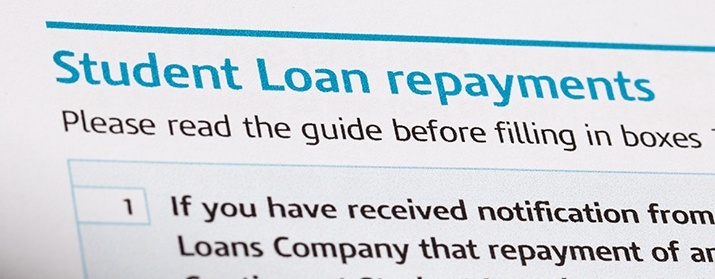
How to Afford a College Degree in Three Simple Steps
If you’re getting ready to apply for college and know nothing about financial aid, or are simply searching for better ways to pay for college, you’re not alone. Over 44 million Americans are currently carrying around 1.28 trillion dollars in student loan debt. As tuition and living costs have risen, more students are forced to get creative to afford their schooling. We’ve broken down ways to pay for college into three easy steps, so that you can minimize your student loan debt and simply worry about acing your next test.
The true cost of a college education
 In order to come up with a strategy to pay for school, you have to understand the true cost of that education – which is often above and beyond the listed tuition rates. The College Board estimated that the average costs for the 2016-2017 school year were $24,610 at an in-state public school and $49,320 at a private school. What costs go into these estimates?
In order to come up with a strategy to pay for school, you have to understand the true cost of that education – which is often above and beyond the listed tuition rates. The College Board estimated that the average costs for the 2016-2017 school year were $24,610 at an in-state public school and $49,320 at a private school. What costs go into these estimates?
- Listed tuition rates
- Room and board
- Books and school supplies
- Campus fees for activities, parking, etc
- Lab or classroom equipment
- Living expenses
It can feel overwhelming, but luckily there are a ton of resources out there to help students afford these costs. All you have to do is follow these steps!
Step one: Apply for FREE money

Many parents and students forget to utilize some of the best resources they have to cut down on the cost of a college education – scholarships and grant money. These forms of financial aid are special and should be your top priority. Why? Because they are FREE! Once you’re awarded a scholarship or a grant, there is never any obligation to pay back that money.
Scholarships
Scholarships are merit-based financial aid. Merit-based means that they are awarded based on a student’s specific skill, ability, or other defining factor. Some examples of this criteria could be:
- Academic grades or GPA
- Community involvement
- Ethnicity
- Extracurricular activities
- Sports
The funds may be distributed to you one time or spread out over the course of your education. Most scholarships will require an application process so that the issuer can determine if the student meets the criteria. Some also require essays to help the decision-makers get to know the applicants and narrow down who will be awarded the aid.
Scholarship providers
All types of businesses and organizations can award scholarships, from the local to the national level. You may find a scholarship offered at any of these places:
- Schools
- Local businesses
- Large companies
- Nonprofits
- Local government
- Religious groups
- Professional organizations
How to find a scholarship that you qualify for
There are billions of dollars of free financial aid from thousands of sources, just waiting for the right person to apply. However, it can be difficult for students to wade through the vast amounts of scholarships to find one that they meet the specific criteria for. Don’t be overwhelmed, there are plenty of resources available to help you narrow down the search.
- Talk to your high school’s counselor. One of their job duties is to help students search and apply for scholarships. They will have an extensive library of options, and will have some of the best knowledge of local businesses and organizations that offer this free money.
- If you’ve narrowed down where you want to attend college, reach out to their financial aid office. Many colleges offer their own scholarship programs to incoming students, and can also direct you towards scholarships that past attendees have taken advantage of.
- Ask your employer if they offer any scholarships to employees. More businesses are setting up scholarship funds every day to help out their younger work force.
- Research online. There are countless websites built solely around curating scholarship opportunities for potential applicants. While many require you to set up a profile, this helps them narrow down what scholarship criteria you meet. They can then focus on showing you scholarships that you may be qualified to receive.
USA Today put together a list of their top ten favorite online resources for scholarships. Some of their favorites included:
AmeriChoice recently partnered with Benefits Plus to offer additional savings and benefits to our members. One of their exciting programs is a specialized scholarship and grant search engine specifically for Benefits Plus users! You can use this tool to apply for scholarships and grants nationwide. The best perk is that even if you’re declined for a scholarship, you still receive a $100 gift card to Office Depot once a month for up to 5 months in the calendar year. That’s enough for a new laptop! Learn more about the Benefits Plus program here.
What happens if you win the scholarship
Congrats! You’ve been awarded the scholarship, what happens next? It all depends on the scholarship. Make sure to ask the issuer if they will be sending the money directly to you in a check, or if they send the funds straight to your chosen school. If they send the funds to the school, it will be applied directly to your tuition fee.
If the funds are not sent straight to the school, you’ll still need to notify the financial aid office of your scholarship award. The combination of financial aid and scholarships cannot equal more than the cost of tuition, so the financial aid office will calculate if any of your other loans can be decreased.
Tips for success
Here are a few tips to follow to ensure your best chance at being awarded free money like scholarships.
- Stay organized, and keep track of deadlines. Scholarships can have wildly different due dates, so find a system that works for you to stay on top of getting your applications in on time.
- Document all of your volunteer service and student activities. Over the years, you may forget about all of the small ways you’ve added to your resume. Keep a list going of every place you’ve volunteered and every extracurricular you’ve participated in. This will make filling out applications much simpler.
Grants
While both types of money are gifted to you, scholarships are based on merit and grants are based on financial need. Keep in mind that while grants are considered gifts, you will be required to repay them if you disqualify yourself from the need-based requirements, either by withdrawing from school, changing your enrollment status, or by receiving outside financial aid that covers the cost of your education.
Federal grant money
The most popular form of grant money comes from the U.S. Department of Education. They offer four types of grants for students.
- Federal Pell Grants
These grants are awarded yearly to undergraduate students. The maximum amount awarded during the 2016-17 school year was $5,815. - Federal Supplemental Education Opportunity Grants (FSEOG)
These grants are awarded directly through your campus’ financial aid office. Each college has a limited amount of funds they can award each year, so get your application in early. The maximum award is $4,000. - Teacher Education Assistance for College and Higher Education (TEACH) Grants
In order to receive this grant, you must agree to study specific coursework and then go on to work at least four years in a highly-needed teaching field at a low-income school. - Iraq and Afghanistan Service Grants
If your parent or guardian was a member of the U.S. armed forces and died as a result of military service in Iraq or Afghanistan, you may be eligible for this grant.
How to apply for a grant
The first step is to fill out the Free Application for Federal Student Aid, also known as the FASFA. This will determine if you meet the need-based requirements of any of the federal grants. You will then work with your college’s financial aid office to determine if you’ve received any grant money and how it fits in with the rest of your financial aid, scholarships, and loans.
Step Two: Apply for CHEAP Money
 Unless you were lucky enough to get a full ride on a scholarship, chances are you will need further assistance in order to afford a higher education. Luckily, the U.S. Department of Education offers not just grants to those in need, but also federally funded student loan programs. These programs offer more competitive interest rates and more favorable repayment options than anything you’ll find in the private lending sector. Plus, all you have to do to apply is fill out the FASFA – which you would have already done to receive federal grant money in step one.
Unless you were lucky enough to get a full ride on a scholarship, chances are you will need further assistance in order to afford a higher education. Luckily, the U.S. Department of Education offers not just grants to those in need, but also federally funded student loan programs. These programs offer more competitive interest rates and more favorable repayment options than anything you’ll find in the private lending sector. Plus, all you have to do to apply is fill out the FASFA – which you would have already done to receive federal grant money in step one.
Types of federal loan programs
The following information was pulled directly from the U.S. Department of Education and was current as of March of 2017. Also double-check the specific interest rates before agreeing to any loan, as they are subject to change.
Perkins loan
These loans are set aside for those with exceptional financial need. Unlike the other types of loans on this list, the school is the lender – not the government. Not all schools participate in this program, so be sure to check with your own college’s financial aid office.
Who qualifies: Undergraduate, graduate, and professional degree-seeking students
Interest rate: 5%
Direct Subsidized Stafford loan
These loans are special because the government is responsible for paying the interest on the loan while you’re in school. This significantly lowers the financial burden of repayment, at the student will only be responsible for paying back the interest and principal amount after graduation.
Who qualifies: Undergraduate students
Interest rate: 3.76%, but the you will not have to pay interest on a subsidized loan while in school
Direct Unsubsidized Stafford loan
These are similar to the subsidized Stafford loan, except you will be responsible for the interest payments while in school. This is the most widely available federal loan program and does not have stringent financial need eligibility requirements. Keep in mind that while you will not be responsible for repayment until after graduation, interest will still accrue on the loan. We recommend paying down the interest through regular payments while still in school.
Who qualifies: Undergraduate, graduate, and professional degree-seeking students
Interest rate: 3.76% for undergraduates and 5.31% for graduate and professional degree-seeking students
Parents PLUS loan
This loan is not under the student’s name, but under their parents. Parents can utilize these funds to help pay for their dependent child’s education, but the parent will be responsible for repayment. The financial need requirements are not strict, but the borrower will need to have a decent credit score.
Who qualifies: Parents of dependent children in undergraduate programs or adults seeking graduate and/or professional degrees
Interest rate: 6.31%
When do I know if I’m eligible and how do I get my federal aid?
Once you’ve found out which schools have accepted you, you should expect to receive a financial aid award letter during the Spring before you attend school. Each school will send their own award letter, which will include federal, state, and institution-specific aid. This letter will breakdown which programs you’ve qualified for, and how much money you can receive.
Before you receive the money, you must sign a promissory note. This note acts as a contract between you and the government. It goes over the specific loan terms and you agree to be held responsible for repayment of the loans. The funds will be disbursed directly to your chosen school, so you do not have to worry about keeping track of making tuition payments with those funds.
Repayment options for federal loans
One of the top reasons to choose federal loans over private loans is the vast amount of repayment plans and deferment options. We’ve put together this table to help you figure out what basic repayment options are available to you as a borrower of federal funds. Visit the U.S. Department of Education to get even further details about unique repayment options that may be applicable to your situation.
Federal Repayment Option Table
| Type | Elligible Loans | Repayment Details | Eligible Borrowers |
| Standard | All direct federal loans | You’ll pay a fixed amount each month for 10 years. This is the plan that all borrowers will default to unless they select otherwise. | All borrowers |
| Graduated | All direct federal loans | Payments will start smaller and then increase incrementally over a 10 year payoff period. The increases are meant to coincide with potential salary increases as you grow your career. | All borrowers |
| Extended | All direct federal loans | Payments can be made on a fixed or graduated scale, but the payment period will be extended to 25 years instead of the standard 10 years to lower the monthly payments. | Requires you to carry a minimum amount of federal loan debt to qualify |
| Income-based (IBR) | All direct federal loans | Your payments will be calculated annually based upon 10-15% of your discretionary income. All debt that remains after 20-25 years will be forgiven, but you will be responsible to pay income tax on that forgiven debt. | Borrowers who are burdened by a high debt to income ratio |
Tip from the experts
 If you can afford it, stick with the standard repayment plan. It will charge less on interest over time than the other repayment options. However, if you would be at risk of defaulting on the loan, absolutely utilize the repayment method that makes it possible for you to continue making monthly payments.
If you can afford it, stick with the standard repayment plan. It will charge less on interest over time than the other repayment options. However, if you would be at risk of defaulting on the loan, absolutely utilize the repayment method that makes it possible for you to continue making monthly payments.
The difference between deferment, forbearance, and forgiveness
Besides the many repayment options available to federal student loan borrowers, there are also an abundance of options for delaying payments or even forgiving the debt altogether. Let’s breakdown the difference between deferring your loans and forgiving your loans.
Deferment
Deferment is when you delay making payments on your loans. The most commonly used deferment is used while you are still a student. While you will continue to be charged interest on unsubsidized loans, you can delay making payments on the principal until six months after graduation. Remember that deferring payments is only a temporary solution. If you think you may not be able to make payments after a grace period, look for other options.
Forbearance
If you’re suffering from an unexpected hardship and can no longer afford your monthly student loan payments, talk directly with your lender about forbearance. It’s another form of delaying payments, but is set up directly with your lender rather than through a designated program. You could get a forbearance up to a year for:
- Health issues that prevent you from making income
- Monthly payments that are totaling more than 20% of your monthly income
- The inability to pay within the maximum loan terms
We recommend only utilizing a forbearance in the case of emergencies, as you will still accrue interest while the loan is sitting unpaid.
Forgiveness
Traditional forgiveness programs
You may have the option for the government to forgive your loan if you fulfill specific tasks. The most utilized forgiveness program is the public service loan forgiveness program. If you work for a federally recognized non-profit or a government organization, you could have your debt forgiven after 10 years or 120 payments. Possible qualifying employers include:
- Federal, state, and local government agencies
- Military service
- Public safety
- Public health
- Public education
- and many more
There are plenty of other forgiveness programs listed on the U.S. Department of Education’s website, so be sure to see if you may qualify! Check out programs that are unique to the state you live in here.
Repayment assistance programs
Some of the repayment plans we covered above offer debt forgiveness after a specified period of on-time payments. Two additional programs that will give you money towards repayment are Americorps and Volunteers in Service to America (VISTA). If you work/volunteer for these organizations for a set period of time, they will contribute funds towards paying off your federal student loans.
Cancellation and discharges
The most important thing to understand about cancelling or discharging a student loan completely is that the ability to do so is extremely rare, even in cases of bankruptcy. A few reasons you could qualify for a federal student loan being discharged without being fully paid are:
- If you’ve died
- If you’ve become totally and permanently disabled
- If your school has closed before you were able to earn your degree
It is more than likely that none of these circumstances will ever apply to you, so focus on selecting a repayment plan that you can afford and working towards eligible forgiveness programs.
Step Three: Fill in the Gaps
 The ideal situation would be for scholarships and cheap federal loans to completely cover the cost of paying for college. But for many students that isn’t the case. If you still need further funds to finance your education, where can you turn? Here are three popular solutions.
The ideal situation would be for scholarships and cheap federal loans to completely cover the cost of paying for college. But for many students that isn’t the case. If you still need further funds to finance your education, where can you turn? Here are three popular solutions.
Private student loans
Many financial institutions, even your local credit union, now offer private lending solutions for students. If you are looking for a student loan from a lender other than the government, make sure to check if they offer the following benefits:
- No origination fees
- Deferment options while you’re still in school
- Flexible repayment terms
- Competitive interest rates
Interest rates will no doubt be higher than a federal loan, but lenders should still be competitive with other financial institution’s rates. It’s important to get a private student loan from a bank or credit union that you trust, and will work with you as a student to make the process simple.
Tip from the experts
If you want to apply for a private student loan, they more than likely will ask for a qualified co-signer. This is because most high school graduates do not have a high enough credit score or long enough credit history to qualify on their own. Make sure you’ve found a responsible co-signer before finishing your application.
Home equity loans
As a parent, there are some additional lending options available to you if you’re a homeowner. A popular way to make tuition payments is by leveraging the equity in your home, either with a home equity loan or a home equity line of credit (HELOC).
These loans work by calculating how much equity you’ve earned on your property, and then letting you borrow up to 80% of that amount with your home as collateral. Home equity loans will give you one, lump sum payment that you pay back over a set period of time with a fixed interest rate. HELOCs give you a specific credit limit that you can repeatedly draw from and pay back over a period of time, with the option to renew the line of credit. Both lending solutions are fairly safe and offer competitive interest rates. But be careful – if you default on either loan, the lender has the option to foreclose upon your home!
Working while in school
If you’re opposed to taking out loans to afford college, one solution may be to continue working while in school. This could allow you to pay your tuition as you go, and not be saddled with student loan debt upon graduating. However, it can be difficult to maintain a work/study balance. You may have to extend the length of schooling by studying part-time so you can maintain a steady work schedule. Or you may fall behind in your studies due to your long working hours.
If you do choose to go this route, make sure you find a job that offers flexible hours and can accommodate your college schedule – as that should be your first priority.
Your Next Steps
 College may be becoming increasingly expensive, but there are a multitude of ways you can pay for college including:
College may be becoming increasingly expensive, but there are a multitude of ways you can pay for college including:
- Free money like scholarship and grants
- Cheap money like federal student loans
- Private student loans and other lending solutions
- Working and paying tuition as you can afford it
If you still have questions, check out our dedicated website for all items relating to student loans, powered by the credit union partner, Student Choice. Enroll in free webinars, search a vast collection of informational articles, and even apply for a private student loan to fill the gap in your financial aid. Check it out here.
-2.png?width=300&height=65&name=AFCU-logo-2019-white-sm%20(1)-2.png)